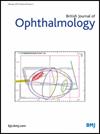Sonographic bleb visualisation after PAUL glaucoma implant surgery
IF 3.7
2区 医学
Q1 OPHTHALMOLOGY
引用次数: 0
Abstract
Background/aims Bleb characteristics in the area around the plate following glaucoma drainage device (GDD) surgery are difficult to evaluate on slit lamp examination. Ultrasound sonography could be used for more detailed visualisation. The aim of this study was to describe bleb configuration after PAUL glaucoma implant (PGI) surgery and evaluate the possible correlation with intraocular pressure (IOP) in order to derive new markers for evaluating GDD function. Methods Patients underwent a 15 MHz ultrasound examination (Compact Touch, Quantel Medical) after undergoing PGI implantation. The filtering bleb dimensions were measured and bleb configuration was assessed along with documentation of all clinical data. Results A total of 70 eyes from 65 patients were included. 55 eyes (78.6%) had a double-layered bleb whereas 15 eyes (21.4%) had a bleb with only one compartment (six eyes, 8.6% above; nine eyes, 12.9% below the plate). The total height of both compartments averaged 3.52 mm. The average IOP was 13.03 mm Hg. There was a significant correlation between single and double-layered blebs (p<0.01) with regard to IOP (one compartment: 16.47 mm Hg vs two compartments: 12.09 mm Hg). There was no significant correlation between total bleb height (p=0.143) or bleb extension (T: p=0.629; L: p=0.742). However, total bleb height showed an inverse association with IOP. Blebs with a height >2 mm had significantly lower mean IOP than those having <2 mm bleb heights (p=0.041). Conclusions Sonography is a suitable modality to evaluate bleb characteristics after PGI implantation. Blebs with a double fluid layer are significantly correlated with lower IOP values. Bleb height has an inverse association with IOP, with higher blebs (>2 mm) showing a significantly lower IOP. Data are available upon reasonable request. All datasets generated during and/or analysed during the current study are available from the corresponding author on reasonable request.PAUL 青光眼植入手术后的声波眼泡成像
背景/目的 在青光眼引流装置(GDD)手术后,通过裂隙灯检查很难评估平板周围区域的眼泡特征。超声波造影可用于更详细的观察。本研究旨在描述 PAUL 青光眼植入体(PGI)手术后的眼泡构造,并评估其与眼压(IOP)之间可能存在的相关性,从而得出评估 GDD 功能的新指标。方法 患者在接受 PGI 植入手术后接受 15 MHz 超声波检查(Compact Touch,Quantel Medical)。测量滤过性眼泡尺寸,评估眼泡结构,并记录所有临床数据。结果 共纳入 65 名患者的 70 只眼睛。55只眼睛(78.6%)的眼睑下垂为双层,而15只眼睛(21.4%)的眼睑下垂仅有一个隔室(6只眼睛,8.6%在眼板上方;9只眼睛,12.9%在眼板下方)。两个隔室的总高度平均为 3.52 毫米。平均眼压为 13.03 毫米汞柱。单层出血点和双层出血点之间存在明显的相关性(p2 mm 的平均眼压明显低于 2 mm 的出血点),显示眼压明显降低。如有合理要求,可提供相关数据。本研究期间生成和/或分析的所有数据集均可向通讯作者索取。
本文章由计算机程序翻译,如有差异,请以英文原文为准。
求助全文
约1分钟内获得全文
求助全文
来源期刊
CiteScore
10.30
自引率
2.40%
发文量
213
审稿时长
3-6 weeks
期刊介绍:
The British Journal of Ophthalmology (BJO) is an international peer-reviewed journal for ophthalmologists and visual science specialists. BJO publishes clinical investigations, clinical observations, and clinically relevant laboratory investigations related to ophthalmology. It also provides major reviews and also publishes manuscripts covering regional issues in a global context.

 求助内容:
求助内容: 应助结果提醒方式:
应助结果提醒方式:


